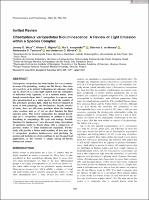Please use this identifier to cite or link to this item:
https://hdl.handle.net/20.500.12202/9621| Title: | Chaetopterus variopedatus bioluminescence: A review of light emission within a species complex |
| Authors: | 0000-0003-1752-0726 |
| Keywords: | Analysis Luciferase Luciferase -- Analysis |
| Issue Date: | 2020 |
| Publisher: | Gale Cengage |
| Citation: | Mirza, J. D., Migotto, A. E., Yampolsky, I. V., de Moraes, G. V., Tsarkova, A. S., & Oliveira, A. G. (2020). Chaetopterus variopedatus Bioluminescence: A review of light emission within a species complex. Photochemistry and Photobiology, 96(4), 768. https://doi.org/10.1111/php.13221 |
| Series/Report no.: | Photochemistry and Photobiology;96 |
| Abstract: | Chaetopterus variopedatus has been studied for over a century in terms of its physiology, ecology and life history. One focus of research is on its intrinsic bioluminescent emissions, which can be observed as a blue light emitted from the extremities of individual body segments, or as a secreted mucus. Even though research shows that C. variopedatus is a species complex miscategorized as a single species, all of the variants of this polychaete produce light, which has been investigated in terms of both physiology and biochemistry. Despite decades of study, there are still many questions about the luminescence reaction, and, as of yet, no clear function for light emission exists. This review summarizes the current knowledge on C. variopedatus luminescence in addition to briefly describing its morphology, life cycle and ecology. Possible functions for luminescence were discussed using observations of specimens found in Brazil, along with a comparison of previous studies of other luminescent organisms. Further study will provide a better understanding of how and why C. variopedatus produces luminescence, and purifying the protein and luciferin involved could lead to new bioanalytical applications, as this reaction is unique among all known luminescent systems. CAPTION(S): Video S1. Bioluminescence of Chaetopterus variopedatus (Annelida, Polychaeta). Light emission was recorded from a specimen kept within a U-shaped glass tube, after chemical stimulation with KCl crystals added directly on the top of the tube. Byline: Jeremy D. Mirza, Alvaro E. Migotto, Ilia V. Yampolsky, Gabriela V. de Moraes, Aleksandra S. Tsarkova, Anderson G. Oliveira |
| Description: | Scholarly article / Open access |
| URI: | https://hdl.handle.net/20.500.12202/9621 |
| Appears in Collections: | Stern College for Women -- Faculty Publications |
Files in This Item:
| File | Description | Size | Format | |
|---|---|---|---|---|
| Oliveira OA Photochem Photobiology - 2020 - Mirza - Chaetopterus variopedatus.pdf | 829.53 kB | Adobe PDF |  View/Open |
Items in DSpace are protected by copyright, with all rights reserved, unless otherwise indicated.
